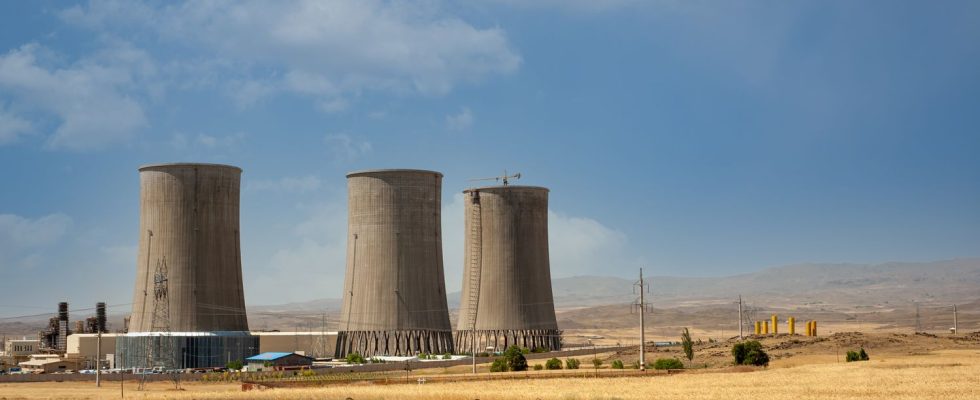Tensions surrounding Iran’s nuclear program are heightened by fears of open conflict with Israel. Although there is no indication that the country has an atomic bomb, it is getting closer.
Published
Reading time: 4 min

How far will the cycle of retaliation go? The Israeli Prime Minister, Benjamin Netanyahu, repeated on Wednesday April 17 that his country “reserved the right to protect himself” facing Iran, after the unprecedented Iranian attack which targeted its territory. On the night of April 12 to 13, the Iranian army launched more than 350 drones towards Israeli territory, in response to a strike against the Iranian consulate in Damascus (Syria) attributed to the Israeli air force. If the vast majority of the devices were able to be intercepted, with the help of several nations allied to Israel, the Israeli executive promised to respond. “We cannot stand idly by in the face of such aggression, Iran will not emerge unscathed from its attack,” proclaimed army spokesperson Daniel Hagari.
Nearly five days after the Iranian attack, the Israeli response has not yet taken place. But several Western officials are calling for restraint, fearing that an Israeli offensive will lead to a regional conflagration with a country whose nuclear program is worrying. For years, this subject has in fact been at the heart of tensions between Tehran and Tel Aviv, which accuses the Islamic Republic of seeking to acquire atomic weapons. Franceinfo summarizes what we know about Iran’s real nuclear capabilities.
Iran no longer respects restrictions
“Today, Iran does not have nuclear weapons”, assures franceinfo Héloïse Fayet, researcher at the French Institute of International Relations, specialist in nuclear proliferation. The Islamic Republic of Iran has been a member of the nuclear non-proliferation treaty since 1968. Signatory states that do not have an atomic bomb undertake not to develop them.
However, Tehran has long been suspected of having turned its back on this commitment. This is the reason why several great powers, including the United States and France, negotiated the Vienna international agreement, signed in 2015, in which Iran accepts, in exchange for the lifting of international sanctions, a supervision of its production of enriched uranium, which can be used in the design of nuclear weapons. But since the United States withdrew from the agreement under the presidency of Donald Trump in 2018, Iran has freed itself from these limits.
According to the International Atomic Energy Agency (IAEA), which monitors the implementation of the agreement, the country continues to increase its production of enriched uranium. On February 20, Iranian stocks stood at 5.5 tons (compared to 4.5 tons four months earlier), or 27 times the limit authorized by the Vienna agreement. Moreover, “the rate of enrichment of Iranian uranium does not correspond to civilian use for electricity and hospitals”, judge Héloïse Fayet. The 2015 agreement imposes a maximum rate of 3.67%, and experts consider that beyond 20%, the objective is not civilian use, even if 90% enrichment is necessary to power a bomb. However, Tehran produces uranium highly enriched to 60%, and had even accelerated its production at the end of 2023, before slowing it down at the start of the year.
Tehran claims the capabilities to develop nuclear weapons
“Iran nevertheless remains very discreet about its nuclear activities,” notes Heloïse Fayet. At the end of February, the IAEA announced “his growing concerns”. Its director, Rafael Grossi, said Tehran had restricted “in an unprecedented way” its interactions with the UN agency, sharply reducing inspection visits to its installations, disconnecting cameras and withdrawing the accreditation of a group of experts.
However, nothing suggests a concrete attempt to obtain atomic weapons from Iran in the near future, says Héloïse Fayet: “There is no sign of militarization of Iran’s nuclear program.” The development of nuclear weapons requires large economic, technical and scientific investments. “Today, the benefit of nuclear weapons is not equal to the costs it represents for Iran”judges the researcher again.
“The main benefit of possessing atomic weapons is nuclear deterrence. But Iran already has a powerful ballistic arsenal.”
Héloïse Fayet, specialist in nuclear proliferationat franceinfo
“Israel is currently hesitant to counterattack for this reason,” continues the researcher. The same hesitations were observed among Western officials. During the IAEA Board of Governors, which opened in early March in Vienna, for example, they decided not to submit a resolution on the Iranian nuclear program so as not to aggravate geopolitical tensions.
Although it does not possess nuclear weapons at this stage, Iran has nonetheless “all the physical means to develop it, all that is missing is political will”, warns Héloïse Fayet. Asked in February about his country’s technical capabilities, Ali Akbar Salehi, former president of the Atomic Energy Organization of Iran, replied that “the scientific and technological thresholds had been crossed”summarizing the situation with a metaphor: “What does a car need? A chassis, an engine, a steering wheel, a gearbox… We have all the components separately”. If that is the case, “it would only take a year or two for Iran to obtain” nuclear weapons, recognizes Héloïse Fayet.
